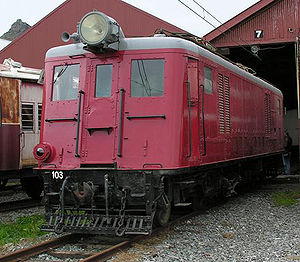- NZR ED class
-
NZR ED class 
ED 103 at Ferrymead Power type Electric Builder English Electric, UK (1),
New Zealand Railways (Hutt Workshops - 7, Addington Workshops - 2)UIC classification 1-Do-2 Gauge 1,067 mm (3 ft 6 in) Length 14.1 m (46 ft 3 in) Locomotive weight 89 short tons (80.7 t) Electric system 1,500 V DC Current collection
methodPantograph Top speed 88 km/h (55 mph), restricted to 70 km/h (43 mph) Power output 1 hour: 925 kW (1,240 hp),
Continuous: 670 kW (898 hp)Tractive effort 80 kN (18,000 lbf) Career New Zealand Railways Number in class 10 Number 101–110
TMS: 15, 21Locale Wellington region First run 1938 Last run March 1981 Disposition 2 preserved The NZR ED class locomotive was a class of electric locomotive used in Wellington, New Zealand. They were built by English Electric and New Zealand Railways between 1938 and 1940, and hauled mainly passenger trains on the Wellington region's 1500 V DC electrification, and banked freight trains on the steep section between Paekakariki and Pukerua Bay.
The locomotives featured a unique wheel arrangement, 1-Do-2 under the UIC classification system, and incorporated a quill drive to the driving wheels.
They were found to be hard on the tracks, leading to speed restrictions on these locomotives and their replacement by the EW class on the Johnsonville Line.
Contents
Classification
Like all other electric locomotives in New Zealand, the leading letter of the locomotives' classification is E. There are two predominant theories about how the ED class acquired the second letter, D. The first is that it comes from the "Do" of its 1-Do-2 wheel arrangement. The second is from its original allocation to two locations, Wellington and Otira - Arthur's Pass, hence "duplicated". Official records provide no confirmation of either theory.[1]
Introduction
New Zealand Railways purchased one ED class locomotive in 1938 from English Electric, No. 101, for use on the newly opened Tawa Flat deviation, which incorporated two long tunnels. This locomotive was known as The Sergeant because of the three longitudional stripes on each side of the body.
The success of this locomotive led to the importation of locomotive components from the United Kingdom for assembly in New Zealand. A further seven locomotives were assembled at the Hutt Workshops and two at Addington Workshops for use on the Otira - Arthur's Pass section of the Midland Line. These locomotives were later transferred north.
Steam Boilers
Each locomotive originally had oil-fired water tube boilers for passenger carriage steam heaters, supplied by the Sentinel Wagon Company. But the boiler, which could supply 1,250 lb of steam per hour at a pressure of 40 lb per sq inch “does not appear to have been used often and has now been removed”. The water and oil tanks had capacities of 400 and 500 gallons respectively, so could steam for four hours before refilling.[2]
Withdrawal
With the introduction of DA class diesels on the Paekakariki via Pukerua Bay to Wellington electrified section in 1967, eight of the class were withdrawn from service in 1969 and scrapped. The remaining two were kept in sporadic service until March 1981, when both locomotives were sold into preservation. ED 101 is preserved by the Silver Stream Railway, while ED 103 is preserved by the Ferrymead Railway.
External links
- Photo of ED 101 at Silverstream 1995 (Internet archive copy)
- Photo of ED loco and train at Paremata (page down)
- New Zealand Diesel and Electric Traction - Class ED (Internet archive copy)
- ED class, photo at Silverstream
- Photo of ED loco outside Preston Works, England c1938
- ED class history
References
Categories:- Locomotives of New Zealand
- English Electric locomotives
- 1500 V DC locomotives
- Electric locomotives of New Zealand
Wikimedia Foundation. 2010.
